ASRock CoreHT 252B Review
by Ganesh T S on September 2, 2011 3:45 AM EST- Posted in
- HTPC
- Intel
- ASRock
- Media Streamer
The ASRock CoreHT 252B is basically a notebook solution. It wouldn't make sense to compare it with full blown desktop Sandy Bridge solutions (or for that matter, any system with a power consumption of more than 100W). In the comparative benchmarks provided in the rest of this review, we will provide the scores obtained by the CoreHT 252B and other similar SFF HTPC solutions.
Windows Experience Index
This metric is often considered meaningless, but we feel it serves as an indicator of what could be the bottleneck in a system for pre-built HTPCs. Surprisingly, it is not the HD 3000 GPU which is responsible for the score of the system. Both the RAM and the hard disk weigh in at 5.9.

The Core i5-2520M supports DDR3-1600 for its DRAM. ASRock could have used the higher speed DRAM and / or a SSD as the primary disk in order to improve this score.
USB 3.0 Performance
The first generation Core 100 HTPC couldn't provide full USB 3.0 performance due to limitations in the HM55 chipset. Compared to the 6 PCI-Express ports in the HM55 chipset, we have 8 in the HM65. This makes it possible for the USB 3.0 controllers to provide full performance.
The CoreHT 252B provides four USB 3.0 ports, two at the front and two at the rear. Renesas (NEC) continues to provide the USB 3.0 controllers for ASRock's mid-range HTPCs. We hooked up OCZ's Enyo 128 GB USB 3.0 external SSD (which has received glowing reviews everywhere with upto 200 MBps read and 190 MBps write speeds) to the various USB 3.0 ports of the CoreHT 252B. Using the Random Access feature of HD Tune Pro 4.50, we obtained the average read and write speeds for random sized accesses to random locations on the SSD. The performance metrics are graphed below.
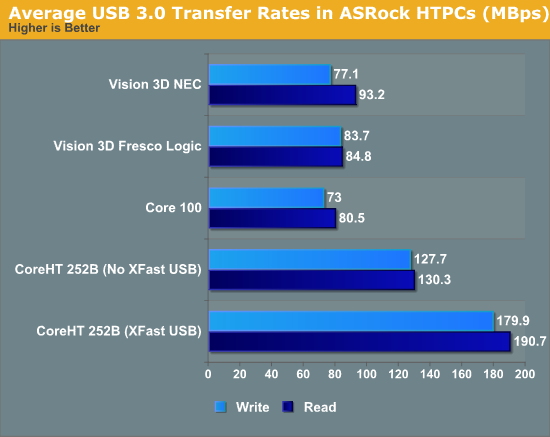
At the outset, it is clear that the USB 3.0 performance improves drastically over the Core 100 and the Vision 3D. ASRock supplies XFast USB, a driver level feature to improve USB performance. As is evident from the above graph, disabling XFast USB seems to have a huge detrimental effect on the performance. In any case, it is advisable for the users to keep XFast USB enabled to get the best out of their system.
Miscellaneous Performance Metrics
The graphs below give an idea of where the ASRock CoreHT 252B stands with respect to performance when compared with other SFF HTPCs. PCMark Vantage's PCMark score gives a general idea of the system's capability.
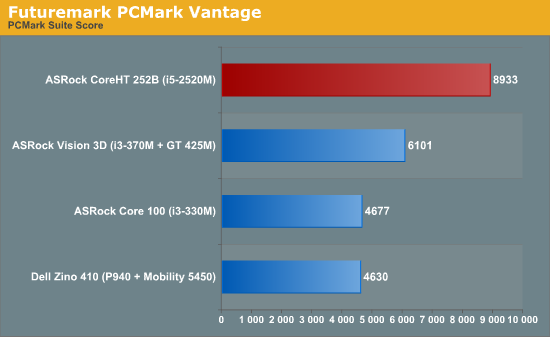
We also ran the 3D Mark Vantage and 3D Mark 06 benchmarks and the graphs below show how the Intel HD Graphics 3000 fares when compared to the GPU capabilities of other pre-built SFF HTPCs.
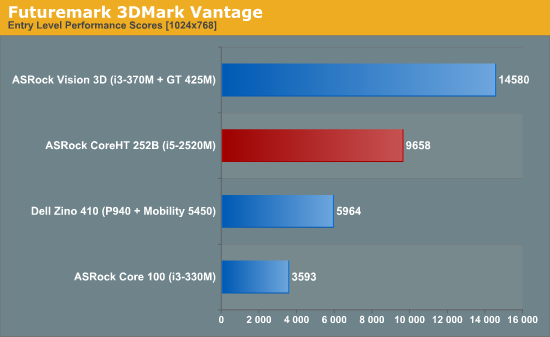

Intel HD Graphics 3000 manages to beat the Mobility 5450 easily in the synthetic benchmarks. In terms of the PC-centric scores, the CoreHT is miles ahead of the SFF HTPCs from last year. This goes on to prove that the bar for the mid-range HTPC just keeps getting higher.
In addition to the above synthetic benchmarks, a couple of commong HTPC workloads were also benchmarked. We have some data on the x264 encoding performance using the i5-2520M. Note that we are unable to utilize QuickSync for this test because QuickSync is unable to provide any for of support for accelerating x264 encode.
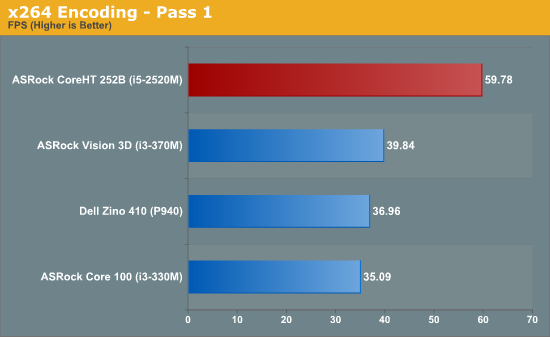
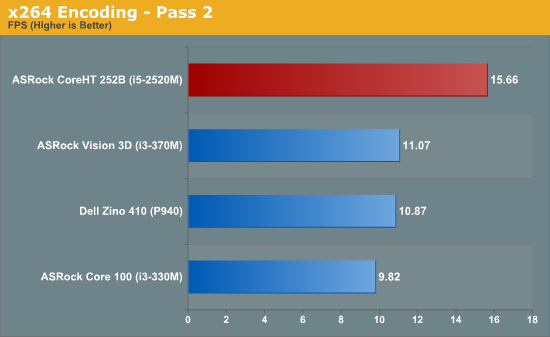
An estimate of how well WinRAR performs, particularly with respect to processing split archives, wraps up this section. To evaluate this, we take a 4.36 GB MKV file, compress it in the 'Best' compression mode into a split archive (97.1 MB each), which results in 44 files on the hard disk. The time taken to decompress this split archive is then recorded. The performance in this benchmark is heavily influenced by the hard disk in the system. It looks like both the CoreHT 252B and the Vision 3D are close to the best possible results in this benchmark, thanks to their 7200 rpm disk.
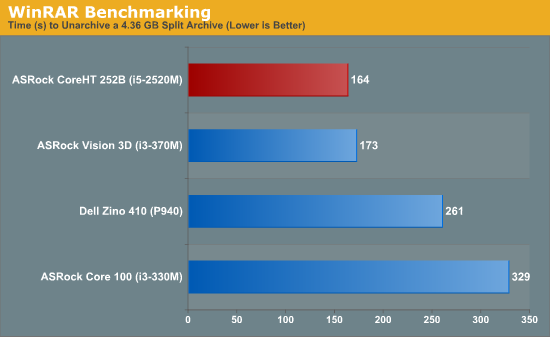
We have deliberately refrained from dealing with gaming benchmarks in this review. Serious gaming enthusiasts know that Intel's integrated GPU is not going to pass muster. For readers interested in finding out how good Intel's HD Graphics 3000 fares in our gaming benchmark, I would suggest looking at Jarred's review of the Asus K53E, which houses a i5-2520M and 6 GB RAM (compared with the i5-2520M and 4GB RAM of the CoreHT 252B that we are dealing with here).










54 Comments
View All Comments
Death666Angel - Friday, September 2, 2011 - link
<<Well, the reviewer only used Windows, hence assuming that one pays for it.>>That would be true, except for the part where in the table on the first page, he writes:
"Operating System Windows 7 Home Premium 64-bit (Retail unit is barebones)"
I agree, however, that he could have stated it clearer in the text when he mentioned the software being shipped with the system ("Our review unit shipped with Windows 7 x64 Ultimate and a OEM version of Cyberlink PowerDVD for Blu-Ray playback.").
ganeshts - Friday, September 2, 2011 - link
Guys, I am keeping track of the developments in the Linux HTPC space.As soon as we can get to a point where it is possible to play Blu-rays with menus (we can already playback encrypted Blu-rays with MakeMKV installed, just not with menus -- this was the state when I last looked at it), we will carry out a detailed Linux HTPC article.
Rick83 - Friday, September 2, 2011 - link
Thanks, looking forward to that!bobbozzo - Friday, September 2, 2011 - link
Hi Ganesh,I don't care about BD so I'd like to see a review even if BD menus don't work.
Thanks for all the HTPC articles!
Miles Prower - Saturday, September 3, 2011 - link
I'm considering buying this machine too, as both a lightweight desktop PC (hey, why not) and a HTPC. Both solutions running Linux.I'd llove to see a review considering XBMC performance and hardware support!
cjs150 - Friday, September 2, 2011 - link
"The unit has a noise level of less than 36 dB at full load "Not good enough. The system needs to be much better 30dB or less. Then there is the issue of how noisy is the Blu-ray drive. In my AV rack the one aspect which really annoys me is the Sony Blu ray player which is clearly audible at quiet points in movies. So would really like to know how loud the optical drive is (why do case manufacturers no include some dampening?)
Having said that it is clearly a very good system . Problem is that Zotac have just announced their AD10 nano system. Whilst it is over priced and lacks an optical drive (not a problem for me as store movies to NAS), in a main room it just looks a far better piece of kit, and a lot smaller (and allegedly quieter)
pvdw - Friday, September 2, 2011 - link
"27 dB during Disc Playback"cjs150 - Friday, September 2, 2011 - link
Oops missed that in the charts.Much better, but I do wonder how much of that noise is due to the Blu ray drive - 22.4 dB on idle and 27 dB on Blu ray playback does not really help me - was this playback from HD or from the optical drive. I can believe the number if from HD, I do not believe the number if from optical drive, but if it is correct then I am impressed. Maybe it is just me, but case manufacturers have spent some time putting vibration dampening grommets for hard disks but never for the optical drives - why? A bit of care might reduce the noise considerably.
The problem is that we keep getting quoted dB and how something is so quiet it is effectively silent when clearly it is not. The standard I work to is very simple. If I can hear a computer during a quiet section of a movie or a song, than it is too loud.
ganeshts - Friday, September 2, 2011 - link
Disc = optical drive. The extra noise is due to the operation of the ODD. Yes, I agree with your metric that if people hear it, it is noisy. However, different people have different tolerance / hearing levels. So, you do need to have some sort of base metric to compare against. For example, at 2 ft, I find 36 dB quite audible. But, only during quiet scenes in the video.Rick83 - Friday, September 2, 2011 - link
note that the measurements were done at 2 feet and not the more or less standardized meter. I'm not going to make the transformation now, as I'm not to keen to get into exponential scaling at this time of day, but it's always important to keep the context of db(A) measures in mind when comparing values.